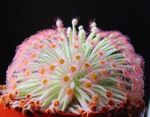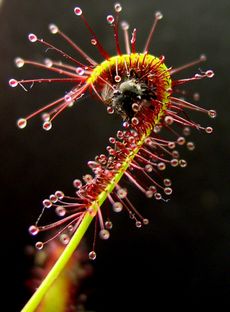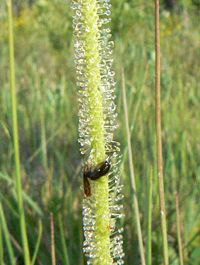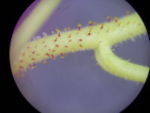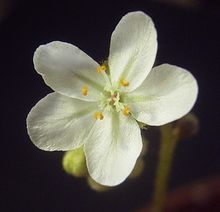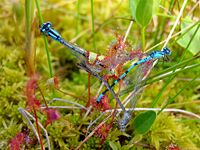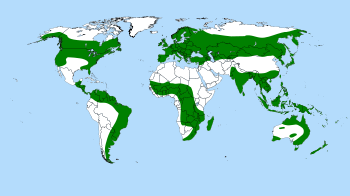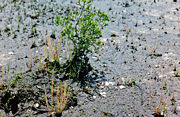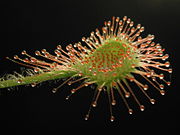Sundew
2008/9 Schools Wikipedia Selection. Related subjects: Plants
| Drosera | ||||||||||||
|---|---|---|---|---|---|---|---|---|---|---|---|---|
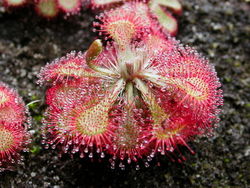 Drosera tokaiensis
|
||||||||||||
| Scientific classification | ||||||||||||
|
||||||||||||
| Species | ||||||||||||
|
See separate list. |
The Sundews (Drosera) comprise one of the largest genera of carnivorous plants, with over 170 species. These members of the family Droseraceae lure, capture, and digest insects using stalked mucilaginous glands covering their leaf surface. The insects are used to supplement the poor mineral nutrition that sundews are able to obtain from the soil they grow in. Various species, which vary greatly in size and form, can be found growing natively on every continent except Antarctica.
Both the botanical name (from the Greek δρόσος: "drosos" = "dew, dewdrops") as well as the English common name (sundew, derived from Latin ros solis, meaning "dew of the sun") refer to the glistening drops of mucilage at the tip of each tentacle that resemble drops of morning dew.
Plant characteristics
Sundews are perennial (or rarely annual) herbaceous plants, forming prostrate or upright rosettes between 1 centimeter (0.4 in.) and 1 meter (39 in.) in height, depending on the species. Climbing species form scrambling stems which can reach much longer lengths, up to 3 meters (10 ft.) in the case of D. erythrogyne. Sundews have been shown to be able to achieve a lifespan of 50 years. The genus is so specialized for nutrient uptake through its carnivorous behaviour that the pygmy sundew is missing the enzymes ( nitrate reductase in particular ) that plants usually use for the uptake of earth-bound nitrates.
Habit
The genus can be divided into several growth forms:
- Temperate Sundews: These species form a tight cluster of unfurled leaves called a hibernaculum in a winter dormancy period (= Hemicryptophyte). All of the North American and European species belong to this group. Drosera arcturi from the mountains of New Zealand is another temperate species that dies back to thick, wiry roots.
- Subtropical Sundews: These species maintain vegetative growth year-round under uniform or nearly uniform climatic conditions.
- Pygmy Sundews: A group of roughly 40 Australian species, they are distinguished by miniature growth, the formation of gemmae for asexual reproduction, and dense formation of hairs in the crown centre. These hairs serve to protect the plants from Australia's intense summer sun. Pygmy sundews form the section Bryastrum.
- Tuberous Sundews: More than 40 Australian species that form an underground corm in order to survive the extremely dry summers of their habitat, re-emerging in the fall. These so-called tuberous sundews can be further divided into two groups, those that form rosettes and those that form climbing or scrambling stems. Tuberous sundews comprise the subgenus Ergaleium.
- Petiolaris Complex: A group of tropical Australian species which live in constantly warm but irregularly wet conditions. Several of the 14 species that comprise this group have developed special strategies to cope with the alternately drier conditions. Many species, for example, have petioles densely covered in trichomes, which maintain a sufficiently humid environment and serve as an increased condensation surface for morning dew. The petiolaris complex sundews comprise the section Lasiocephala.
Although they do not form a single strictly defined growth form, a number of species are often put together in a further group:
- Queensland Sundews: A small group of three species ( D. adelae, D. schizandra and D. prolifera), all native to highly humid habitats in the dim understories of the Australian rainforest.
Leaves and carnivory
Sundews are characterised by the glandular tentacles, topped with sticky secretions, that cover their laminae. The trapping and digestion mechanism usually employs two types of glands: stalked glands that secrete sweet mucilage to attract and ensnare insects and enzymes to digest them, and sessile glands that absorb the resulting nutrient soup (the latter glands are missing in some species, such as D. erythrorhiza). Small prey, mainly consisting of insects, are attracted by the sweet secretions of the peduncular glands. Upon touching these, however, they become entrapped by sticky mucilage which prevents their progress or escape. Eventually, the prey either succumb to death through exhaustion or through asphyxiation as the mucilage envelops them and clogs their spiracles. Death usually occurs within one quarter of an hour. The plant meanwhile secretes esterase, peroxidase, phosphatase and protease enzymes. These enzymes both dissolve the insect and free the contained nutrients. The nutrient soup is then absorbed through the leaf surface and can then be used to help fuel plant growth.
All species of sundew are able to move their tentacles in response to contact with digestible prey. The tentacles are extremely sensitive and will bend toward the centre of the leaf in order to bring the insect into contact with as many stalked glands as possible. According to Charles Darwin, the contact of the legs of a small gnat with a single tentacle is enough to induce this response. This response to touch is known as thigmotropism, and is quite rapid in some species. The outer tentacles (recently coined as "snap-tentacles") of D. burmannii and D. sessilifolia can bend inwards toward prey in a matter of seconds after contact, while D. glanduligera is known to bend these tentacles in toward prey in mere tenths of a second! In addition to tentacle movement, some species are able to bend their laminas to various degrees in order to maximize contact with the prey. Of these, D. capensis exhibits what is probably the most dramatic movement, curling its leaf completely around prey in 30 minutes. Some species, such as D. filiformis, are unable to bend their leaves in response to prey.
A further type of (mostly strong red and yellow) emergences has recently been discovered in a few Australian species ( D. hartmeyerorum, D. indica). Their function is not known yet, they might probably help attracting prey.
The leaf morphology of the species within the genus is extremely varied, ranging from the sessile ovate leaves of D. erythrorhiza to the bipinnately divided acicular leaves of D. binata.
Flowers and fruit
The flowers of sundews, as with nearly all carnivorous plants, are held far above the leaves by a long stem. This physical isolation of the flower from the traps was originally thought to be an adaptation meant to avoid trapping potential pollinators; a recent study, however, indicated that Drosera attract distinct types of insects as pollinators and prey, with little overlap. Instead, the tall flower stalks probably help raise the flowers to a height where they are noticeable to pollinators. The mostly unforked inflorescences are spikes, whose flowers open one at a time and usually only remain open for a short period. Flowers open in response to light intensity (often opening only in direct sunlight), and the entire inflorescence is also helitropic, moving in response to the sun's position in the sky.
The radially symmetrical ( actinomorphic) flowers are always perfect and have five parts (the exceptions to this rule are the four-petaled D. pygmaea and the eight to twelve-petaled D. heterophylla). Most of the species have small flowers (<1.5 cm. or 0.6 in.). A few species, however, such as D. regia and D. cistiflora, have flowers 4 centimeters (1.5 in.) or more in diameter. In general, the flowers are white or pink. Australian species display a wider range of colors, including orange ( D. callistos), red ( D. adelae), yellow ( D. zigzagia) or metallic violet colored ( D. microphylla).
The ovary is superior and develops into a dehiscent seed capsule bearing numerous tiny seeds.
Roots
The root system of most Drosera is only weakly developed. It serves mainly to absorb water and to anchor the plant to the ground; the roots are relatively useless when it comes to nutrient uptake. A few South African species use their roots for water and food storage. Some species have wiry root systems that remain during frosts if the stem dies. Some species such as Drosera adelae and Drosera hamiltonii use their roots for asexual propagation, by sprouting plantlets along their length. Some Australian species form underground corms for this purpose, which also serve to allow the plants to survive dry summers. The roots of pygmy sundews are often extremely long in proportion to their size, with a 1 centimeter (0.4 in.) plant extending roots over 15 centimeters (6 in.) beneath the soil surface. Some pygmy sundews, such as D. lasiantha and D. scorpiodes, also form adventitious roots as supports. Drosera intermedia and D. rotundifolia have been reported to form arbuscular mycorrhizas.
Reproduction
Many species of sundews are self-fertile and flowers will often self-pollinate upon closing. Often copious amounts of seeds are produced. The tiny black seeds germinate in response to moisture and light, while seeds of temperate species also require cold, damp, stratification in order to germinate. Seeds of the tuberous species require a hot, dry summer period followed by a cool, moist winter to germinate.
Vegetative reproduction occurs naturally in some species that produce stolons or when roots come close to the surface of the soil. Older leaves that touch the ground may sprout plantlets. Pygmy sundews reproduce asexually using specialized scale-like leaves called gemmae. Tuberous sundews can produce offsets from their corms.
In culture, sundews can often be propagated through leaf, crown, or root cuttings, as well as through seeds.
Distribution
The range of the sundew genus stretches from Alaska in the north to New Zealand in the south. The centers of diversity are Australia (with roughly 50% of all known species), South America (20+ species) and southern Africa (20+ species). A few species are also found in large parts of Eurasia and North America. These areas, however, can be considered to form the outskirts of the generic range, as the ranges of sundews do not typically approach temperated or Arctic areas. Unlike previously supposed, the evolutionary speciation of this genus is no longer thought to have occurred with break-up of Gondwana through continental drift. Rather, speciation is now thought to have occurred as a result of a subsequent wide dispersal of its range. The origins of the genus are thought to have been in Africa or Australia.
Europe is home to only three species: D. intermedia, D. anglica, and D. rotundifolia. Where the ranges of the two latter species overlap, they sometimes hybridize to form the sterile D. × obovata. In addition to the three species and the hybrid native to Europe, North America is also home to four additional species; D. brevifolia is a small annual native to coastal states from Texas to Virginia, while D. capillaris, a slightly larger plant with a similar range, is also found in areas of the Caribbean. A third species, D. linearis, is native to the northern United States and southern Canada. D. filiformis has two subspecies native to the East Coast, the Gulf Coast, and the Florida panhandle.
This genus is often descriped as cosmopolitan, meaning that it has worldwide distribution. The botanist Ludwig Diels, author of the only Monograph of the family to date, called this description an "arrant misjudgment of this genus' highly unusual distributional circumstances" („arge Verkennung ihrer höchst eigentümlichen Verbreitungsverhältnisse“), while admitting that sundew species do "occupy a significant part of the Earth's surface" („einen beträchtlichen Teil der Erdoberfläche besetzt“). He particularly pointed to the absence of Drosera species from almost all arid climate zones, countless rainforests, the American Pacific Coast, Polynesia, the Mediterranean region, and North Africa, as well as the scarcity of species diversity in temperate zones such as Europe and North America.
Habitat
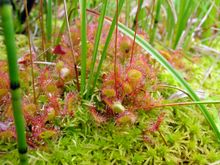
Sundews generally grow in seasonally moist or more rarely constantly wet habitats with acidic soils and high levels of sunlight. Common habitats include bogs, fens, swamps, marshes, the tepuis of Venezuela, the wallums of coastal Australia, the Fynbos of South Africa, and moist streambanks. Many species grow in association with sphagnum moss, which absorbs much of the soil's nutrient supply and also acidifies the soil, making nutrients less available to plant life. This allows sundews, which don't rely on soil-bound nutrients, to flourish where more dominating vegetation would usually outcompete them.
That being said, the genus is very variable in terms of habitat. Individual sundew species have adapted to a wide variety of environments, including atypical habitats such as rainforests, deserts (ex. D. burmannii and D. indica), and even highly shaded environments (Queensland Sundews). The temperate species, which form hibernacula in the winter, are an example of such adaptation to habitats; in general, sundews tend to prefer warm climates, and are only moderately frost-resistant.
Conservation status
Although none of the Drosera species in the United States are federally protected, all are listed as threatened or endangered in some states. Additionally, many of the remaining native populations lie on protected land such as National Parks or Wildlife Preserves. Drosera species are protected by law in many European countries, such as Germany, Austria, Switzerland, Czech republic, Finland, Hungary, France, and Bulgaria. Currently, the largest threat in Europe and North America is that of habitat destruction for development projects, as well as the draining of bogs for agricultural uses and peat harvesting. In many regions this has led to the extinction of some species from parts of their former range. Re-introduction of plants into such habitats is usually difficult or impossible, as the ecological needs of certain population is closely tied to their geographical location. Through increased legal protection of bogs and moors as well as a concentrated effort to renaturalize such habitats, the threat to these plant's survival might be curbed, although most species would remain endangered. The relatively unimpressive image of these plant as well as their small, low growth makes them difficult to protect. As part of the landscape, sundews are often overlooked or not recognized at all.
In South Africa and Australia, two of the three centers of special diversity, the natural habitats of these plants are undergoing a high degree of pressure from human activities. Expanding population centers (such as Queensland, Perth, and Cape Town) threaten many such habitats, as does the draining of moist areas for agriculture and forestry in rural areas. The droughts that have been sweeping Australia over the last ten years also pose a threat to many species by drying up previously moist areas.
Those species that are endemic to a very limited area are often most threatened by the collection of plants from the wild. D. madagascariensis is considered endangered in Madagascar because of the largescale removal of plants from the wild for exportation; 10 - 200 million plants are harvested for commercial medicinal use annually.
Uses
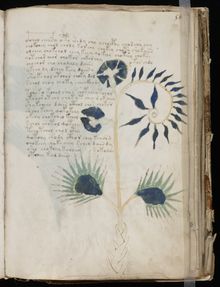
As a medicinal plant
Several medicinally active compounds are found in sundews, including flavonoids ( kaempferol, myricetin, quercetin and hyperoside), quinones (plumbagin, hydroplumbagin glucoside and rossoliside (7 – methyl – hydrojuglone – 4 – glucoside)), and other constituents such as carotenoids, plant acids (e.g. butyric acid, citric acid, formic acid, gallic acid, malic acid, propionic acid), resin, tannins and ascorbic acid (vitamin C).
Sundews were used as medicinal herbs as early as the 12th century, when an Italian doctor from the School of Salerno by the name of Matthaeus Platearius described the plant as an herbal remedy for coughs under the name "herba sole". It has been used commonly in cough preparations in Germany and elsewhere in Europe. Sundew tea was especially recommended by herbalists for dry coughs, bronchitis, whooping cough, asthma and "bronchial cramps". A modern study has shown that Drosera does exhibit antitussive properties. Sundews have also been used as an aphrodisiac and to strengthen the heart, as well as to treat sunburn and prevent freckles. They are still used today in some 200-300 registered medications, usually in combination with other active ingredients. Today Drosera is usually used to treat ailments such as asthma, coughs, lung infections, and stomach ulcers.
Medicinal preparations are primarily made using the roots, flowers, and fruit-like capsules. Since all native sundews species are protected in many parts of Europe and North America, extracts are usually prepared using cultivated fast-growing sundews (specifically D. rotundifolia, D. intermedia, D. anglica, D. ramentacea and D. madagascariensis) or from plants collected and imported from Madagascar, Spain, France, Finland and the Baltics.
As ornamental plants
Because of their carnivorous nature and the beauty of their glistening traps, sundews have become favorite ornamental plants - however, the environmental requirements of most species are relatively stringent and can be difficult to meet in cultivation. As a result, most species are unavailable commercially. A few of the hardiest varieties, however, have made their way into the mainstream nursery business and can often be found for sale next to Venus fly traps. These most often include D. capensis, D. aliciae, and D. spatulata.
The more difficult species of sundews are also cultivated by a group of several thousand carnivorous plant enthusiasts world wide; virtually every species can be found in cultivation. Since many sundew species are only found in small numbers in a very limited range in the wild, several species have been threatened by aggressive collection of plant material for cultivation.
Cultivation requirements vary greatly by species. In general, however, sundews require a high environmental moisture content, usually in the form of a constantly moist or wet soil substrate. Most species also require this water to be pure, as nutrients, salts, or minerals in their soil can stunt their growth or even kill them. Commonly plants are grown in a soil substrate containing some combination of dead or live sphagnum moss, sphagnum peat moss, sand, and/or perlite, and are watered with distilled, RO, or rain water.
Other uses
The corms of the tuberous sundews native to Australia are considered a delicacy by the Australian Aborigines. Some of these corms were also used to dye textiles, while another purple or yellow dye was traditionally prepared in the Scottish Highlands using D. rotundifolia. A sundew liqueur is also still produced using a recipe that has its roots in the 14th century. It is made using fresh leaves from mainly D. capensis, D. spatulata, and D. rotundifolia.
Phylogenetics
|
The unrooted cladogram to the right shows the relationship between various subgenera and classes as defined by the Rivadavia et al.'s analysis in 2002. The monotypic section "Meristocaules" was not included in the study, so that its place in this system is unclear. More recent studies have placed this group near section "Bryastrum", so it is placed there below. It should also be noted that the placement of "Section Regiaea" in relation to "Aldrovanda" and "Dionaea" is uncertain. Since the section "Drosera" is polyphyletic, it shows up multiple times in the cladogram (*).
This phylogenetic study has made the need for a revision of the genus even clearer.

